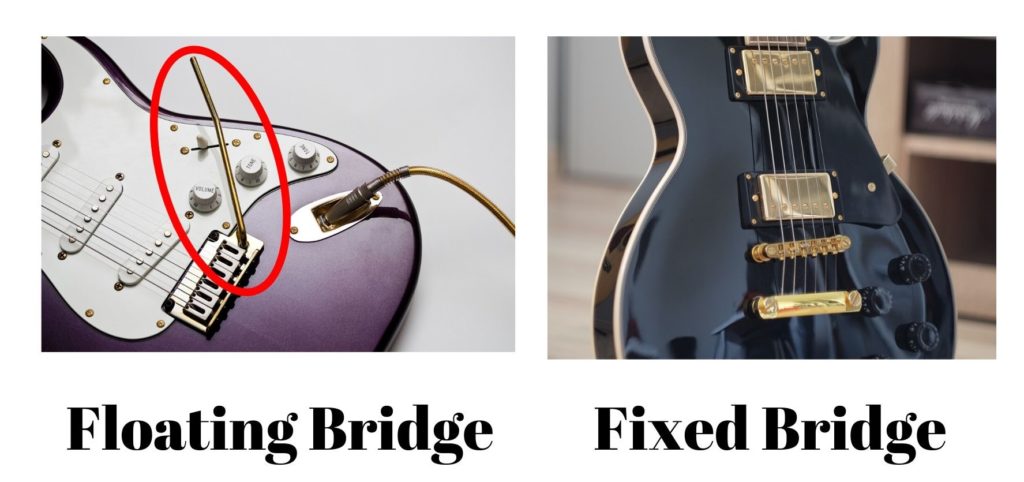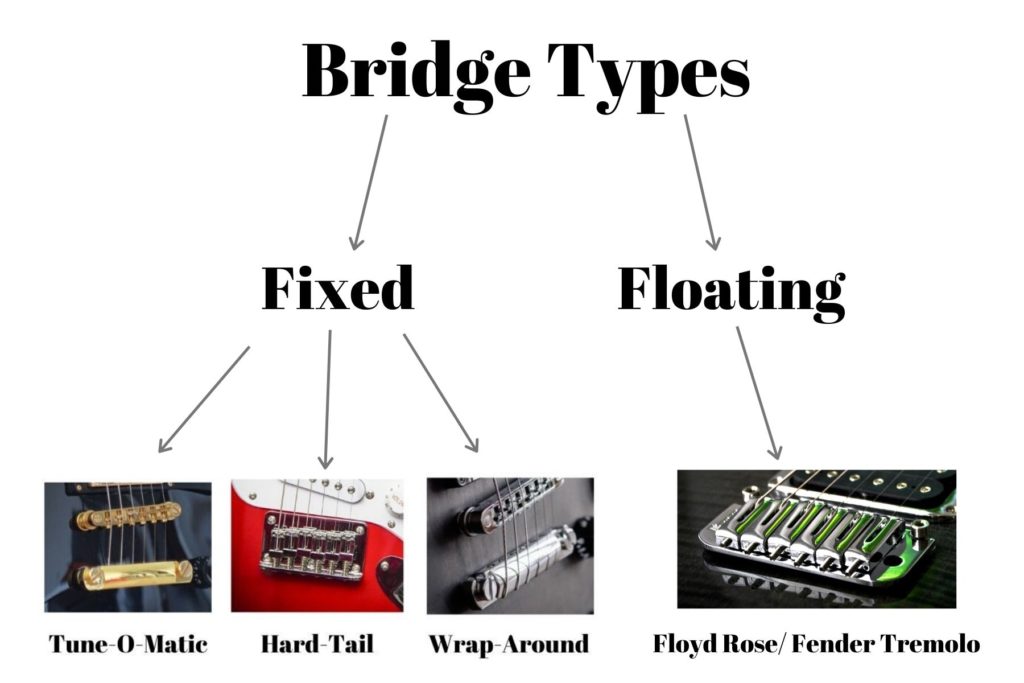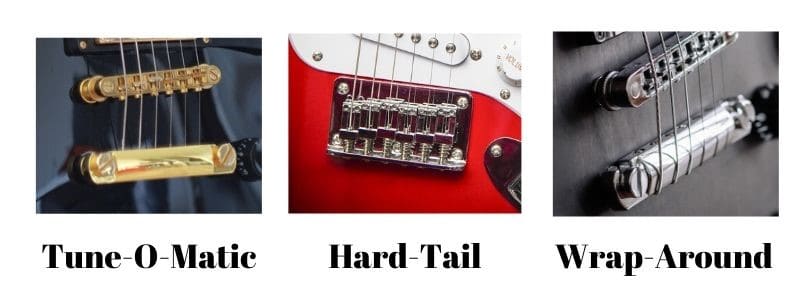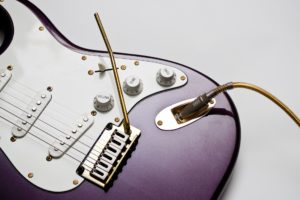There are two main types of bridges on an electric guitar: fixed and floating. But what does this actually mean? And which is the best one? I’ll go through an in-depth comparison between fixed and floating bridges so you can decide which is the best for you. So let’s get started!
The Quick Answer
If you want a super quick answer then here are a few points and diagrams so you get the take home message.
- Fixed bridges have a saddle and bridge where the strings pass through and this acts as the end point of the strings on the guitar.
- Floating bridges have an additional feature, the tremolo arm, which allows you to change the pitch of the strings by bending or pulling on it. The strings also pass through the body of the guitar instead of ending at the saddle.

What are the Pros and Cons?
The main difference between a floating a fixed bridge is the tremolo arm. With a floating bridge, you can use this arm to add a vibrato effect to your playing, but you can’t do this with a fixed bridge.
However, floating bridges come with some drawbacks. They’re hard to setup and repair, they can also limit tuning stability and perhaps most importantly, they make string changing a more difficult process.
There are also a few different types of fixed and floating bridges which each have their own pros and cons. Keep reading to find out more about each bridge type.

What is a Fixed Bridge?
A fixed bridge is also known as a hardtail bridge. This is when the bridge is screwed down to the body of the guitar, and there are six adjustable saddles which fit each string. It’s the most simple kind of guitar bridge and it’s very easy to manage and adjust.
Which Guitars use fixed bridges
Many different kinds of guitars use fixed bridges. The most famous ones as the Gibson Les Paul and the Fender Telecaster. Some Fender Strats also use the hardtail bridge, but some also use the floating bridge.
Types of Fixed Bridges
There are several different types of fixed bridges, which can often cause confusion. So here’s a quick rundown of the most common fixed bridges and how they differ from each other.
- Tune-o-Matic Bridge: this is when the bridge and saddle are separate. The bridge sits before a bar which has 6 different saddles on it.
- Wrap Around Bridge: in this case the strings are actually wrapped around the saddle after the bridge.
- Hard-Tail Bridge: this is when the bridge and saddle are in combination and the saddle is adjustable for each string.

Advantages
- Easy to re-string
- Simple to adjust the action
- Good tuning stability
Disadvantages
- Some designs are uncomfortable
- No tremolo option
What is a Floating Bridge?
Floating bridges are also known as tremolo bridges. They do what fixed bridges, in that they provide an end-point for the strings on the guitar’s body, but they also have an additional function that fixed bridges can’t do.
Floating bridges allow you to use a tremolo which means you can change the pitch of the strings once they’ve been plucked by moving the tremolo arm up or down. This is known as vibrato.
Which Guitars Use Floating Bridges
The Fender Stratocaster is well known for having a tremolo bridge which can set up to “float”, however many other brands also use them. For example, a lot of PRS guitars have a tremolo bridge. Floating bridges are popular with heavy rock and metal music, so manufacturers like Ibanez and Jackson also use floating bridges often.
Types of Floating Bridges
There are a few different types of floating bridges, but two are very common, the Fender Tremolo and the Floyd Rose Floating Bridge.
- Fender Tremolo: this is well-known as the first true floating bridge. The strings pass through the body and are locked on the bridge.
- Floyd Rose Bridge: this is an adaptation of the Fender Tremolo. It is a double locking system instead of a single locking system which means it stays in tune better.
Fender Tremolos can be further divided into 2 and 6 point systems. Check out my article comparing 2 and 6 point tremolos to learn about their pros and cons.
Make sure you check out my in-depth comparison between Fender Tremolo and Floyd Rose bridges to learn how they work and find out their pros and cons.

Advantages
- Tremolo arm
- Comfortable
Disadvantages
- Hard to change strings
- More fragile and hard to adjust
Which Bridge Type is Best?
Now you know a bit more about the floating and fixed bridges and their sub-types, it’s time to compare them head to head. I’ll start by saying that there is no real answer to which bridge is best, it’s all personal preference and depends what you value most. So let’s go through the main differences:
- Sound
- String changing
- Tuning stability
- Setup and repair
Sound Differences
The main difference between the sound of a floating and fixed bridge, is due to the tremolo arm. Using the word “tremolo” can be a little confusing. You see, tremolo refers to variations in volume. But that’s not what the tremolo arm does. Instead, it causes variations in pitch, aka, vibrato.
By either pushing down on the tremolo arm, or pulling it up, it puts pressure on the strings or relives pressure respectively. You can do this when you’re playing to change the pitch of all the strings at the same time. This is really useful when you’re playing chords or individual notes.
So in summary, if you want to be able to use a tremolo arm to add this vibrato effect, then you want a floating bridge as you can’t do this with a fixed bridge.
String Changing
So the most notable disadvantage of the floating bridge, is that it makes string changing a lot more difficult. This is because, with floating bridges, the strings go the entire way through the guitar’s body to the back. But with fixed bridges, the strings simply end at the saddle on the top of the guitar.
This means that changing the strings can be a bit of a nightmare with floating bridges if you’re a beginner.
Tuning Stability
Another disadvantage of floating bridges, is that it makes the tuning stability of the guitar weaker, so it’s likely to go out of tune faster.
This is more of an issue with Fender Tremolos than with Floyd Rose Bridges, as the double locking system on the latter prevents the guitar going out of tune as much. However, it’s hard to do big bends on the tremolo arm without having tuning stability issues.
Setup and Repairs
One of the other issues with the floating bridge is that they take a lot more setting up and maintenance than fixed bridges.
Floating bridges contain springs that need carefully balancing which fixed bridges do not require. If the balance is not correct, then you’ll definitely get tuning issues, even if you’re not using the tremolo arm.
It can also be a nightmare if you need to change a string quickly. You can’t just restring one string simply like you can with a fixed bridge. You’ll need to make sure the bridge is balanced again and make adjustments to the springs.
If you’re in the market for a new guitar, make sure you check out my complete electric guitar buyer’s guide to ensure you get the perfect model.
In Summary
So to round things off, deciding on which type of bridge is best for you, depends on two things.
- Do you want the vibrato effects that the tremolo arm on floating bridges offers?
- Can you deal with the issues with floating bridges like more difficulty changing strings, less tuning stability and harder setup and repair?
If the answer to both those questions is yes, then go for the floating bridge. But if your answer is no, then the fixed bridge is the one for you!
Guitar Center are always the first place I look at when I’m interested in a new electric guitar because have a huge range of models for sale and always have some excellent deals on. Here’s a link to take you directly to Guitar Center’s electric guitar range so you can see all the offers available at the moment.
So there you go! That’s the difference between a floating and fixed bridge! I hope you’ve found this article helpful, thanks for reading, and have fun shopping for a new guitar or amp! Here are some other posts you might find useful:
